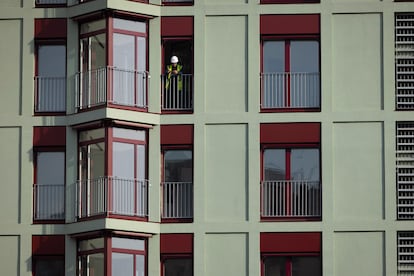A single person, between 35 and 65 years old, of Spanish nationality and poor: with an annual income that does not exceed 8,600 euros. This is the majority profile of applicants for officially protected housing in 2023 in the register of the Housing Agency of the Generalitat of Catalonia and that of Barcelona City Councilthe only one that has its own list. This is shown by the Catalan administration report from the end of last year, when the total number of applicants was 92,745 people. Ten months later, applications are close to 100,000, agency sources point out.
Going down to detail, requests from households made up of a single person are the most numerous, 46% of the total. 23% are households with two people, 14% with three, and households with four or more members do not even reach 10% each. The data breaks down large families, which are only 7.8% of applicants; and single parents, with 7.4% of the total. People with disabilities are only 1% of applicants. By age groups, the bulk of applicants are people between 35 and 65 years old (61% of all those who request VPO), those between 18 and 35 represent 27%; and those over 65, 12%.
The data also shows that three out of every four registered applications (75%) are from people of Spanish nationality. A quarter are from people born in non-EU countries and applications from community members do not even reach 1% (232 applications out of a total of almost 93,000). These percentages have remained stable over time since 2010, when the registry was created as a result of the Right to Housing Law of the tripartite government of PSC, ERC and ICV. The percentage of applicants of foreign origin is higher than their presence in the Catalan population (25% of applicants compared to 13.5% in the census, according to Idescat). which is explained by the higher incidence of poverty among migrants.
The political scientist, expert in urban studies and director of the Institute of Government and Public Policies (IGOP), Ismael Blanco, attributes the difference in percentages to the fact that “the risk of poverty rate among the foreign population in Catalonia (39.9% ) triples that of the Spanish population (13%), and in the metropolitan area of Barcelona it quadruples.” “There are not as many applicants as would be appropriate if we look at their poverty levels,” he concludes regarding poverty data that does not distinguish between community and non-community migrants, where the risk of vulnerability is even higher.

In fact, just like living alone, poverty It is a common denominator among almost half of the people who apply for public housing. 47% are below the Income Sufficiency Indicator of Catalonia (IRSC), “the level of income below which it is considered that one cannot live with dignity and allows access to economic benefits.” In 2023 in Catalonia it was 8,600 euros per year. After this period, 37% of the applications are from households that earn up to 2.3 times the IRSC (19,800 euros per year). If the income of the household and the people who make it up are combined, the poorest people who live alone are once again the majority.
Among the issues raised in the report, there is a discrepancy between the type of social housing most requested by citizens and the one that is being produced. While the majority of VPO that is currently awarded is rent88% of the requests request the rental with option to purchase modality and 37% purchase apartments. Less than half, 48%, request rental apartments. And 8% of the total (which correspond mainly to the city of Barcelona) are homes with surface rights. That is, built by entities or cooperatives on land donated by the municipalities, normally for 75 years, but in which the administration does not lose ownership of the land.
The data in this report from the Generalitat focuses on public housing applicants whose applications have been accepted, because they meet the requirements, and are being processed, the Agency explains. They do not include the figures and profiles of the recipients of social housing. In Catalonia, any person of legal age who does not own a home can apply for public housing (or if they do have one but it is in a dilapidated state or is substandard housing, among other exceptions). Other requirements are to be registered in a municipality in Catalonia, meet the income limit established by the regulations on social housing (they are weighted based on the income of the cohabitation unit taking as a reference the IRSC, the members of each unit and weighted based on the geographical area where the home is located) and not have any circumstance that would lead to exclusion as an applicant. These are having renounced an awarded social housing or that the registration was revoked due to changes in the original conditions of the registration in the registry. Registration cannot be repeated within five years following the date of resignation or revocation of the application. It is also important to know that applications must be renewed year after year to keep them alive.

